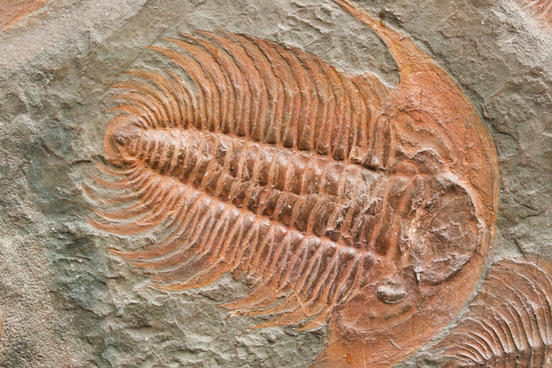I mention all this to explain why on a gray day in February I went to the Natural History Museum in London to meet a cheerful, vaguely rumpled, very likeable paleontologist named Richard Fortey.
我提這一切,是為了解釋為什么我在陰沉沉的一天前往倫敦的自然史博物館,會(huì)見一位性格開朗、有點(diǎn)不修邊幅、非常討人喜歡的古生物學(xué)家。他的名字叫理查德·福泰。
Fortey knows an awful lot about an awful lot. He is the author of a wry, splendid book called Life: An Unauthorised Biography, which covers the whole pageant of animate creation. But his first love is a type of marine creature called trilobites that once teemed in Ordovician seas but haven't existed for a long time except in fossilized form. All shared a basic body plan of three parts, or lobes—head, tail, thorax—from which comes the name. Fortey found his first when he was a boy clambering over rocks at St. David's Bay in Wales. He was hooked for life.
福泰的知識(shí)面極廣。他是一本幽默而又精彩的書的作者,書名叫做《生命:一部未經(jīng)授權(quán)的傳記》。該書涉及創(chuàng)造生命的全過程。但是,他最鐘愛的是一種名叫三葉蟲的海生動(dòng)物。那種動(dòng)物一度充滿奧陶紀(jì)的海洋,但早已不復(fù)存在,除了以化石的形式。三葉蟲的身體都有個(gè)相同的基本結(jié)構(gòu),分為三個(gè)部分或三片葉——頭、尾和胸。三葉蟲的名字由此而來。福泰在孩提時(shí)代就發(fā)現(xiàn)了第一個(gè)三葉蟲化石,當(dāng)時(shí)他正攀越威爾士圣戴維海灣的巖壁。結(jié)果,他一生都對(duì)三葉蟲著了迷。
He took me to a gallery of tall metal cupboards. Each cupboard was filled with shallow drawers, and each drawer was filled with stony trilobites—twenty thousand specimens in all.
他把我?guī)У揭粋€(gè)四周都是高高的金屬柜子的陳列室。每個(gè)柜子上都有許多不深的抽屜,每個(gè)抽屜里都塞滿了三葉蟲化石——總共有2萬件標(biāo)本。

It seems like a big number, he agreed, "but you have to remember that millions upon millions of trilobites lived for millions upon millions of years in ancient seas, so twenty thousand isn't a huge number. And most of these are only partial specimens. Finding a complete trilobite fossil is still a big moment for a paleontologist."
“看來真是不少,”他表示同意,“不過,你要記住,成萬億只三時(shí)蟲在古代的海洋里生活了成億年,因此2萬這個(gè)數(shù)字不算多。而其中大部分僅僅是不完整的標(biāo)本。發(fā)現(xiàn)一塊完整的三葉蟲化石對(duì)古生物學(xué)家來說,仍是一件大事。”
Trilobites first appeared—fully formed, seemingly from nowhere—about 540 million years ago, near the start of the great outburst of complex life popularly known as the Cambrian explosion, and then vanished, along with a great deal else, in the great and still mysterious Permian extinction 300,000 or so centuries later.
三時(shí)蟲最初出現(xiàn)在大約54000萬年以前,接近復(fù)雜生命大爆發(fā)即通常所謂的寒武紀(jì)大爆發(fā)的起始時(shí)刻。它們已經(jīng)完全成形,仿佛從天而降。然后,在30000萬年以后。三葉蟲跟許多別的生物一起在二疊紀(jì)大滅絕的時(shí)候消失了。那次大滅絕至今仍是個(gè)謎。












